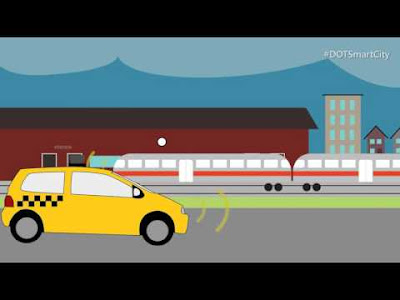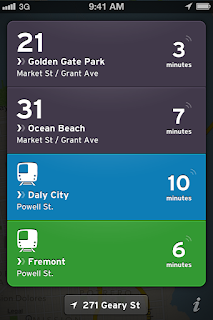What Makes a City Smart?
For all the talk about smart cities a lot of dumb stuff happens in cities. Chicago can't get a grip on police violence, Flint poisons its citizens with municipal water, Washington DC's Metro subway is befallen by a series of mishaps and Baltimore can't count its primary votes so that the State has to de-certify the election results. The voting debacle is interesting because even though Maryland went from a smarter technology (touch screens) back to paper, the problems all seem to arise at the one point where technology is still deployed, the scanners that paper ballots are fed into once filled out,and which either misfired, or were mis-fed with provisional ballots that shouldn't have been scanned. In some instances the little data sticks were lost or misplaced. Technology problems are not a first for Baltimore. Baltimore's data collections about red light running and inner urban speeds were so poor that parked cars were shown speeding or running red lights and the entire system had to be switched off for lack off proper calibration. The switch for the camera's has stayed firmly in the off position for over two years despite repeated new RFPs and re-start attempts. The red light camera story may be extreme since many cities run these systems without a hitch; nevertheless it is rife with lessons about how data get collected, who collects the data, and who benefits.
 |
| Smart City Conference, China |
Residents would like their cities to be smarter, act more informed and allocate their resources wisely. They also want to protect their privacy and want to be protected from abuse. The Baltimore red light story also shows how even large supposedly reputable companies like Xerox can take the municipality for a ride. If the hardware to collect data and the software to interpret it comes from private companies, they remain in charge, even after the city pays for the equipment or the company defaults. These tricky conditions have prevented Baltimore from simply switching the vendor but leaving all the expensive hardware in place.
The Maryland Transit Agency has vehicle locator systems on board of their buses, except these are radio based, unreliable because of signal interference and they do not provide the correct data feed needed to feed the transit option of Google maps. So the maps show static schedule info instead of real time arrivals. To provide riders with the benefit of real time, MTA installed a few electronic signboards that most of the time showed either only static schedule info or nothing at all. Trying to improve on that, all 8,000 bus stops were equipped with little signs giving a specific access and stop number for obtaining real time arrival via texting from a smart phone. Thanks to the finicky nature of the radio signal emitting from the bus, this venture, too, remained largely unsuccessful and third party apps like Transit App outperform the MTA texting system easily.
Since Edward Snowden made the pervasive nature of government data collection public knowledge, the term Big Data has become a term that is equally a promise and a threat.
 |
| Smart City Challenge, DOT |
These few examples show that the talk about the Smart City can easily be hype if the basic infrastructure of cities isn't working, and that includes hard infrastructure such as roads and rails themselves. The best real time app is useless if there is no WiFi in a subway tunnel or the train itself isn't running because of track fires or emergency repairs as was recently the case in Washington DC. Even more this is the case for soft infrastructure such as the bandwidth and speed of internet connections, persistently troubled items in most large American cities where all smart apps routinely collapse where large crowds gather or some calamity has struck that makes everybody use their mobile phone at once.
One doesn't have to be a Luddite to note these deficiencies and problems that we encounter now, long before we even attempted much in terms of the Internet of Things. As we have learned in previous technological revolutions, technology is only as good as its users allow it to be. This holds true, even when in a revolution that allows things humans couldn't do before (something that applied also to the steam engine, the airplane and the automobile, all items that have been deployed with varying degrees of smartness). The effectiveness of the smart city will largely depend on how we deploy resources, what questions we ask and what theories and policies we will put into place.
Yet, the promise of big data, sensing urban infrastructure, and data based planning and decision making is undoubtedly there.Turning it into a reality will become ever more urgent with the growing complexity of cities due to the new cities' sheer size, higher expectations regarding services and quality of life coinciding with increasing threats of environmental degradation.
 |
| Portlnad 20 minute neighborhoods |
As such, it is an imperative that the potential of evidence-based planning and design be harnessed along with the possibilities of positive feedback loops. This can happen from data sensing and data reading in which residents are not only the providers of data (as smart phone users who drive are by providing location and speed data for traffic congestion maps) but also the beneficiaries by getting the information about congestion in time to avoid it. In such a dynamic feedback loop the real time information exchange alters the outcome, i.e. congestion gets mitigated by the choices drivers make once they know about it. The traffic example illustrates the possibilities; it isn't the best use of data necessarily, since issues of transport go much deeper than simple congestion mitigation. To stick with the topic of transportation, just imagine the dynamic of the Google or Waze traffic maps could be transferred to transit so we wouldn't just get real time bus and train arrival times, but the schedule would dynamically change based on demand. We are still far away from that, except in vertical transportation (elevators). In tall towers elevator dispatch is now being optimized by user input allowing the transport of more riders with fewer elevator cars.
Smart cities will only really be smart if a large number of people can participate in the process of setting goals, policies, data review and general interaction. The more complex a system is, the more it relies on the corrective measure of a large input base. Complex systems, run in a top down authoritative manner, may be efficient in a very short term, but they are destined to spectacularly crash as soon as the intuition of the strong leader fails. Privacy and equity in data processing is a huge concern, of course, that can only be addressed with policy. Technology alone won't provide the solution.
 |
| Real time bus information |
Transportation, again, may demonstrate what is at stake. If smart cars self driving cars become the norm, it is policy and goal setting that will determine if the technology becomes a nightmare or a blessing. Giving sprawl another boost, because people would now not mind a long commute during which they can do work or watch a show which would cause them to move even further away from where they work, because cars are still privately owned, parked during 95% of their life and taking up way too much space to park. On the blessing side, the new technology ccould be used to deploy the automobile resources more effectively by practically never parking them and deploying them like a driver-less Uber service. In this case cities could recover vast amounts of space for more productive uses and the flow of vehicles could be optimized in a transportation system with fluid lines between transit and movement of individual people.
Increasingly, humanity appears to find itself in a position where technology outruns policy and goal setting. When it comes to the smart city, in spite of all the talk about the big data, one has to search a long time to find mayors, departments or administrations who have begun to actually address the policy and governance issues or who have appointed anybody in charge o0f those imminent technologies. That is not only not promising but a real threat to a sustainable future.
Even more importantly, new goals are needed, outside of the current set of solutions to creatively apply what technology may offer. Technology needs to be paired with creativity so its potential can be unleashed in a way that benefits most people.
Klaus Philipsen, FAIA
edited by Ben Groff, JD
